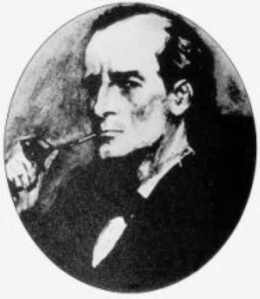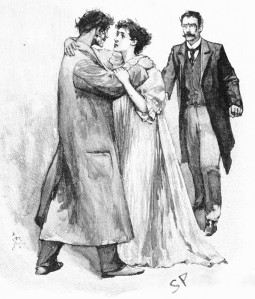“The Nefarious Holmes”

“At the track he left nothing to chance,” wrote Red Smith. Holmes did know Wilson, the notorious canary trainer.
We have just the one obscure, tantalizing aside. Deciphering the sole reference to golf in the Sherlock Holmes stories would require the deductive reasoning skills of the Great Detective himself.
It comes at the beginning of The Greek Interpreter from the Memoirs of Sherlock Holmes, published in 1894, a date worth noting as a bullish time for golf in Victorian England.
Holmes and Dr. Watson are at ease, which is in itself, in a way, instructive.
It was after tea on a summer evening, and the conversation, which had roamed in a desultory, spasmodic fashion from golf clubs to the causes of the change in the obliquity of the ecliptic, came round at last to the question of atavism and hereditary aptitude. The point under discussion was, how far any singular gift in an individual was due to his ancestry and how far to his own early training.
Enough about the obliquity of the ecliptic, give us more about those clubs! Isn’t it interesting that “golf clubs” came first in the conversation? A comfortable departure point among friends – if one isn’t supposing too much. An ice breaker with Holmes, who was so often an intimidating, diffident or poor casual conversationalist, naturally so when considering a mystery.
So who brought up the clubs in conversation? I’m guessing Watson. And, for the record, do gentlemen with little interest in golf informally sit down – then or now – with a dear friend and begin discussing golf clubs if they don’t play? I think not.
We now move to even shiftier sands. Does the author mean by golf clubs the places one ventures to play the game, any number of which were springing up across the British landscape at that time. Or, does he mean the implements of the Royal & Ancient Game – perhaps something splendid from Tom Stewart Jr.’s shop in St. Andrews, favored by the newly-crowned J.H. Taylor, having bested the Scots at their own game, or a new innovation deadly in the hands of any number of exceptional amateurs?
Holmes is worthy of speculation. Of Sir Arthur Conan Doyle’s relationship to golf, the case is iron-clad. Recently I had the pleasure of admiring his actual clubs. They were on exhibit at the Harry Ransom Center at the University of Texas at Austin. “Sport and Literature” presented a most eclectic collection of the museum’s sporting memorabilia and ephemera. There was a first edition of Casey at the Bat, costumes and personal notes from Robert DeNiro’s role in Bang the Drum Slowly (“practice spitting”), asides from William Faulkner on quarterbacking his high school team, and Pierce Egan’s magnificent Volume One of Boxiana; or Sketches of Ancient and Modern Pugilism; from the days of the reopened Broughton and Slack to the Heroes of the Present Milling Aera, By One of the Fancy (1818).
Conan-Doyle’s clubs were a pleasant and unexpected surprise. Another jaw-dropper was mounted nearby: a single page of the tightly scripted, original manuscript, of The Hound of the Baskervilles. The exhibit notes describe the author as a “natural athlete and avid sportsman, listing among his physical culture pursuits: football, hockey (a common sport in Great Britain and frequently referenced by those who turned in later years to the new Victorian passion for golf), rugby (ditto), swimming and skiing.
“Yet Doyle’s great love,” we learn, “was golf. He golfed wherever and whenever he could,” including, to the bemusement of hard scrapple Vermonters, in bucolic Brattleboro, when the snow relented in early spring.
The clubs displayed (reading from my notes; the exhibit closed in August) included: three irons, two woods, driver (missing whipping), brassie (also “loose”), a beautiful aluminum Mills putter, and a jigger with (certainly suggestive) extra whipping. It was too dark to get more information on the make, but there was no mistaking these were not, if you’ll excuse the phrase, museum pieces. The clubs bore obvious signs of repeated use. It is also interesting to learn that, in 1901, while playing golf with a friend, Fletcher Robinson, Robinson shared to Conan Doyle the story about a “demon beast said to haunt the Dartmoor moors. “The friends immediately began crafting Holmes’s most famous adventure.” Funny, how so many creative endeavors begin in the fresh air in pursuit of a little ball.

An original illustration from “The Greek Interpreter,” with golf given only a passing, though tantalizing, mention.
Back to more on Holmes, again quoting from the exhibit materials, we learn he “was an expert with singlestick and foil, a fine boxer equally accomplished with rifle and small arms and had a knowing eye for horseflesh.”
To this last point we turn to another critical eye, a learned man with rapier wit and insight, if perhaps not expert in singlestick and foil. Red Smith did, however, know something about horseflesh, and about those nefariously attracted to its profitable potential.
In two columns, back-to-back in 1954 (collected in View of Sport, 1954), Smith takes “the best and wisest man” known to Dr. Watson to sporting task. He fully lets himself go in The Nefarious Holmes and The Game’s Afoot.
Holmes is implicated as a “horse player of degenerate principles who thought nothing of fixing a race,” and that “whenever his activities impinged upon the field of sports, he exhibited a singular moral slackness, an ethical blind spot of shocking dimensions.”
It’s a scathing, wonderful, poke in the sanctimonious chops. You may reach for the collected works for a welcome re-reading of Silver Blaze. Decide for yourself what motives might’ve existed for Holmes not disclosing the stolen horse’s whereabouts. “As I stand to win a little on this next race,” he tells Watson, “I shall defer a lengthy explanation.” (To which Red takes immediate umbrage. “At the track,” he cuts to the quick, “he [Holmes] left nothing to chance.”)
All ripping good stuff. Despite the lack of apparent evidence, Holmes certainly had a golfer’s mien, and temperament. It’s not hard to believe the game’s subtler twists not appealing to his sporting, or gambling, instincts. But surely, his clubs would’ve been in better shape than the state his creator left his.
I’ve not mentioned two self-published books by one of the growing legion of Holmes (and Watson) fans who have borrowed the leads to their one ends. Two books, one entitled Sherlock Holmes The Golfer, the other Sherlock Holmes Saved Golf, written by Bob Jones, a longtime member of the Golf Collectors Society, for the record, appeared years ago, for those so inclined to pursue a thread I think best left to the one who knew him best.